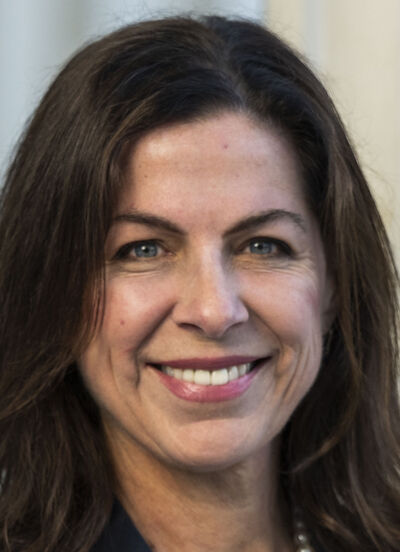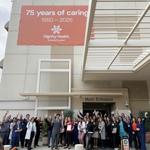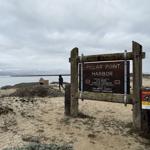California voters could be deciding on a nearly $16 billion climate bond — which environmental advocates say would help San Mateo County address increasingly urgent vulnerabilities to sea level rise, erosion, flooding and other impacts of climate change.

Diane Papan
“For us, it’s existential,” Len Materman, CEO of San Mateo County flood resiliency and sea level rise entity OneShoreline, said. “All these sectors — housing, transport, society, utility — we have high vulnerability. Not to mention the people, corporations and small businesses.”
San Mateo County, with the San Francisco Bay on one side and the Pacific Ocean on the other, leads the state in outsized vulnerability to sea level rise and high tides, creating impending dangers for homes, infrastructure and businesses, Materman said.
Assemblymember Diane Papan, D-San Mateo, co-authored Assembly Bill 1567, the California Assembly’s version of a climate bond bill currently awaiting policy committee referral. The California Senate has a similar bill also awaiting review by policy committees and, pending passage, legislators will work to create an amalgamation of the two, Papan said.
“It is tremendously important to San Mateo County to be resilient against climate change,” Papan said. “Rising sea levels, both [on the] coast and Bay tributaries that flow from the east, from the mountains as well. In other words, we’re getting it from all directions.”
Bond structure
The bond is targeted for California’s November general election ballots, although Papan noted that the Assembly bill’s current fiscal commitment — $15,995,000,000 — could potentially be scaled back before it reaches voters.
The bill delineates funding for different areas of climate resiliency, including wildfire prevention, drought preparation and flood prevention. It was originally structured through broad categories so local agencies can apply for funding based on need and project goals, Papan’s District Director David Burruto said.
San Mateo County agencies could apply for grant funding earmarked for the San Francisco Bay Restoration Authority or the San Francisco Bay Area Conservancy Program, for example. Under the bill’s current iteration, each agency would have $250 million to allocate, and funding could also be received through other sources.
But some, like Margaret Bruce, executive director of the San Francisquito Creek Joint Powers Authority, worry there won’t be enough money for urban flooding and sea level rise.
“I look at the bond measure and I think, ‘wonderful, this is great. And we're going to need more,’” she said. “When the electorate looks at the price tag, I worry that unless there is a sustained campaign or a sustained message about this sense of down payment … I worry [about this] being sort of a one and done and ‘why are you coming back for more, didn’t we fix this problem?’”
Potential bond projects
The San Francisquito Creek Joint Powers Authority is currently developing plans for the SAFER Bay project, designed to protect the East Palo Alto and Menlo Park area from urban flooding. The project — which aims to protect the area from up to three and a half feet of sea level rise — is in the environmental impact review stage and is approaching 30% design, Bruce said.
“This is where we are starting to put forward what we think would be the optimal alignment and the placement of the structures, how big they would be, where they would be, how tall they would be and what they would be made up of,” Bruce said, noting that the design standard meets FEMA accreditation to exempt individuals from flood maps and subsequent flood insurance requirements in the future.
SAFER Bay was delineated as a project that could use climate bond funding to move forward, David Lewis, executive director of Save the Bay, said. Significant investment into large-scale projects like these, which covers a swath of seven miles, can actually save communities money in the long run, Lewis said.
“These investments are costly, but if you can help prevent these disasters from harming people and property and infrastructure and habitat, then you don’t have to spend more money recovering,” he said. “More money up front, save money later.”
Two other San Mateo County environmental projects in design phases — the Burlingame Shoreline Park project, which aims to create a public park and restore marshland, and the Colma Creek restoration, which would restore tidal banks and expand tidal marshes — have been pointed out as examples of projects in need of funding by the State Coastal Conservancy.
But Materman said that if the county receives substantial funding from the potential climate bond, they should go larger in scope, uniting areas along the Bayfront that don’t currently have plans for climate resiliency.
“Knit together the 53 miles of shoreline, where you have some areas that have done nothing and some areas that have done construction. That’s what I think a big picture climate bond should be focused on,” he said.
Currently, the SAFER Bay project would cover seven miles of Bayfront in East Palo Alto and Menlo Park. A proposed Bayside levee system in Redwood Shores would protect parts of Redwood City, San Carlos and Belmont, and OneShoreline has suggested an off-shore sea barrier that would offer flood protection for Millbrae and Burlingame, reaching to the San Francisco International Airport.
Additionally, Foster City has built a wall around the city that will provide some level of protection, although it isn’t a long-term solution, Materman said.
Recommended for you
That leaves three areas of San Mateo County unprotected. One is Redwood City, in between Marsh Road — where the SAFER Bay project ends — and Redwood Shores. Another is the San Mateo city shoreline, and the last area is north of SFO, including South San Francisco and Brisbane.
“Smaller projects, I think those are good projects, they should be done, they should find funding … [but] let’s focus on bringing everybody up to the same level of protection. We don’t have too many funding opportunities to do that big stuff and we should focus on that,” he said.
By contrast, on the coastside, Materman said he would advocate for specific, large-scale projects to take place to protect major infrastructure, like the water treatment plant in Half Moon Bay, two former landfills on the bluffs — one in Daly City and one in Half Moon Bay — and Highway 1.
Funding climate resiliency
While Materman said his goal is to begin studies in all areas of the county in need of climate protection by 2025, he acknowledged that funding climate resiliency projects will take not only state money from a potential climate bond, but funding from local and even federal agencies as well.
Local communities have a significant role to play in transitioning state and federal funding into actionable goals and projects for their specific communities, Bruce said.
“We want them to be aware of our individual needs. We want them to be aware of our community's needs, and to do things that address them. But practically speaking, they do have to paint with a mop,” she said. “It’s our community's responsibility to figure out how to get the details and to prioritize the details and to take action at the detailed level.”
Communities can also play a role in obtaining that funding, Lewis said, pointing to a 2016 Bay Area parcel tax measure to generate half a billion dollars over 20 years to restore tidal marshes and salt ponds. In 2007, the total cost for restoration was $1.4 billion.
“It’s sort of the signature approach the Bay has taken. We know this work is going to cost money, we know there’s public support for it,” he said. “Instead of throwing up our hands at the cost, we have worked to create public funding.”
Climate equity and challenges
However, there are also extensive challenges that come from grant-based models that the climate bond will likely follow, especially for smaller organizations that don’t have full-time grant writers.
“It’s a lot of competition. Everybody is going after these funds,” Violet Saena, founder and executive director of Climate Resilient Communities — a San Mateo County environmental advocacy group for under-represented communities — said.
Even when money becomes available, it isn’t a guarantee by any means that a project will be able to acquire it.
“We also understand that other vulnerable communities need the funding too, so that's why it's a tough situation of making new resources available and then we have to compete for it,” Saena said.
Beyond equity issues in obtaining funding, climate injustice can present itself in other systemic ways, like the Federal Emergency Management Agency’s cost benefit ratio — which creates prioritization for protections on high-property-value communities, often leaving lower-income communities behind, Bruce said.
“For every dollar investment, we save more than $1 in property value. But if you don't have high value property, you can't make that case. So cities like Menlo Park may easily score high and get a grant, whereas cities like East Palo Alto may not. Their risks may be the same, but because their property values are different, they don't have access to the same funding,” she said.
For Materman, the solution to these equity issues are broad-scope projects that project major swaths of land, combining lower and higher value areas of shoreline into one project.
And regardless of what shape proposed climate bond funding will take and what issues it will address in specific, the price tag of the proposed bond is an inevitable step required to address climate change in San Mateo County and statewide, Papan said.
“We all know that these are urgent matters with really big dollar signs attached to them,” Papan said. “A bond is no surprise to anybody.”
(650) 344-5200 ext. 105
































(5) comments
Of course Diane Papan is the politician least credible to claim she finally understands Climate change. She is responsible for creating arguably more carbon than all of us combined. She approved the 101 highway widening which is responsible for an estimated additional 140,000,000 vehicle miles traveled (VMT) per year [source UC Davis].
Her Transit-oriented-developments are anything but and her Grade Separation projects feature 4-6 car lanes, but nothing for bicycles. She even voted against North Central bike lanes despite all the "climate action goals", Vision Zero and Transportation Equity she and her city claimed to care about.
But now she apparently found religion in Sacramento.
"“For us, it’s existential,” Len Materman, CEO of San Mateo County flood resiliency and sea level rise entity OneShoreline, said. “All these sectors — housing, transport, society, utility — we have high vulnerability. Not to mention the people, corporations and small businesses.” I don't feel vulnerable at all and I also had the good sense not to buy or build a house on a cliff. And this guy pretends to speak for all of us, including those who are not convinced that climate change is even existential? Yet, this non-elected person, probably backed by labor unions, will stick us with an enormous bill for years to come. How they did they come up with $16B anyway? Just a wag, right? Vote NO on everything these types propose.
Dirk, you're the wise man "25 The rain came down, the streams rose, and the winds blew and beat against that house; yet it did not fall, because it had its foundation on the rock. 25
I read the guilt trip so-called government leaders are trying to lay on taxpayers, but this is to be expected. Supposedly, this man-made climate change has been happening for a long time and now it’s become a priority? Let’s get down to what’s more important… How much is this $16 billion bond going to cost CA taxpayers when I have no doubt most of the proceeds will go to pay ever increasing pensions and benefits? Depending upon the bond rate and term, this $16 billion may cost taxpayers $38 billion. Due to the change in income tax receipts (as expected) the state is running out of money for their public employees and benefits.
Vote NO on any bonds or any fees/taxes/etc. that goes to city or state coffers. Fortunately for some, they have the money to leave CA. Unfortunately for those left behind they’ll have to make up the difference. Voters get the government they deserve.
2,000 years ago the great weather man Prophetic Jesus Christ said "24 “Therefore everyone who hears these words of mine and puts them into practice is like a wise man who built his house on the rock. 25 The rain came down, the streams rose, and the winds blew and beat against that house; yet it did not fall, because it had its foundation on the rock. 26 But everyone who hears these words of mine and does not put them into practice is like a foolish man who built his house on sand. 27 The rain came down, the streams rose, and the winds blew and beat against that house, and it fell with a great crash.” Matthew 7: 24-27
Welcome to the discussion.
Log In
Keep the discussion civilized. Absolutely NO personal attacks or insults directed toward writers, nor others who make comments.
Keep it clean. Please avoid obscene, vulgar, lewd, racist or sexually-oriented language.
Don't threaten. Threats of harming another person will not be tolerated.
Be truthful. Don't knowingly lie about anyone or anything.
Be proactive. Use the 'Report' link on each comment to let us know of abusive posts.
PLEASE TURN OFF YOUR CAPS LOCK.
Anyone violating these rules will be issued a warning. After the warning, comment privileges can be revoked.